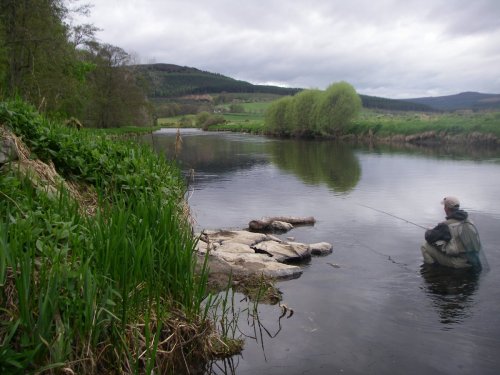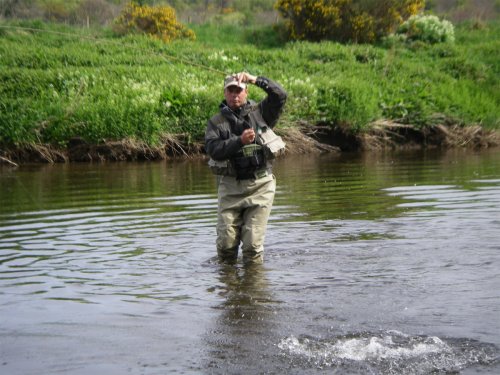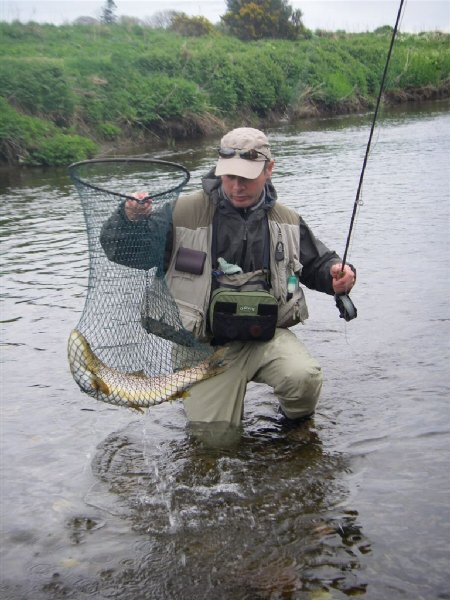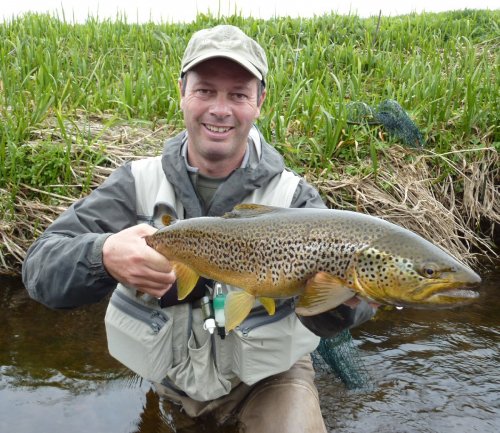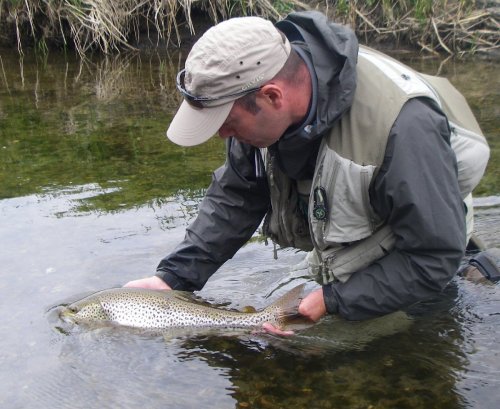The last 8 years has seen my emphasis shift towards large, wild river trout...
The last 8 years has seen my emphasis shift towards large, wild river trout. And whilst it's reckoned that at some point, all fishermen make a conscious effort to catch a big 'un', it really did creep up on me. Following a few outings to rivers noted for their hefty residents, suddenly, I was being consumed. Odd really, when you consider the first three trips ended in failure! Despite this lack of initial success there's something positively magical and almost primitive about pursuing monster trout. Moreover, a great sense of satisfaction is gained from researching and visiting rivers reputed to hold such leviathans. And when you're finally confronted with a fish that's pushing plenty of water about, words fail me, so let's just say; emotions run high way before the first cast is ever contemplated. Furthermore, any encounter with a substantial fish tempted on light tackle will undoubtedly leave you a babbling wreck for several minutes afterwards.
First up, with all this talk of specimens, let's put things into perspective. I still maintain that a wild UK river trout topping a pound in weight is a notable fish with the magical 2 pounder being something special and anything over 3lb-a fish of a lifetime. Of course, as the size bracket increases, the actual number of fish tends to decrease, making trout is excess of 5lb a rare creature indeed. With that, it's vital we return such fish, as these potential have the genes to produce our next generation of rod benders.
Pursuing big trout means making sacrifices. Simply covering water blind isn't really an option. Sure, you'll tempt fish, but percentage wise, the odds of connecting with a larger trout are vastly reduced. Of course, it could be argued that concentrating your efforts in certain areas where you last saw or suspect a large trout to be might work. However, random fishing takes time and before you know it the hours slip away. Besides, these fish have definite feeding and resting lies, all in very different areas and if trout haven't moved to a given feeding station, there's little hope of a response.
Talking of lies, trout, especially big ones like a sense of security, usually in the form of depth. A nice deep pool is perfect for them to hole up during periods of rest. From here they head out to feed with any one fish commanding several preferred lies close to home. Which lie a trout chooses to occupy at any given time usually depends on water and overhead conditions? Under cloud cover or higher than normal water levels, many good fish can take up station in surprisingly shallow runs. On my home waters, typical places include close to banks, up against tree trunks and more likely on the tail of a pool. Tail outs might appear unlikely places for secretive, nervous trout, yet having seen and caught so many big fish from these areas it's usually my first port of call.
Various structures should never be ignored either, fallen trees, submerged roots, sunken logs, large boulders and undercut banks are all fishy lairs. At times, I've seen monstrous trout evaporate into the thinnest of gaps beneath a boulder. On another occasion, moving between known lies on my local river, passing a lengthy stretch of skinny water (about knee deep) I spooked a good trout. As the fish moved off that telltale 'V' wake made straight for a semi submerged tree trunk. Having never seen much in this stretch before, I'd pretty much written it off. Four return visits later, a cracking 3lb 2oz lay in the net, taken from that particular lie.
Many assume heavier tackle helps when it comes to playing trout. Sure, using increased tippet strengths gives insurance, though stout monofilament may compromise presentation. A copolymer tippet of 5lb covers most eventualities. Balanced tackle is the answer and I'm confident using my trusty 4-weight rod. This may seem a light outfit, but not only does it protect appropriate tippet strengths in relation to fly size, wielded properly the rod tires fish extremely quickly. It's a case of understanding the marriage between rod angle and pressure. Simply put, when playing trout, a more vertical rod tip applies less strain and should be maintained during the explosive runs of freshly hooked fish. Pointing a rod more directly towards the trout brings the powerful butt section into play and piles on pressure, as does tilting a rod sideways into a horizontal plane. This way trout can be brought to hand in literally no time. On a recent trip we netted fish of 4lb 7oz and 3lb 15oz in less than two minutes.
Some form of company isn't a bad thing, especially when venturing onto unknown water. Mainly because it halves the leg work and two minds think better than one. Morale support plays an important role too, as long periods of inactivity often see enthusiasm ebb away. Like minded mate Richard Tong has exploration in his veins. Locating active fish often involves lots of walking, on one trip Richard and I covered some 7 miles of water then there was the equally long trudge back to our vehicle, in a downpour without waterproofs. Grounds for choosing your friend with care!
Do your homework and sniff out rivers reputed for producing significant fly hatches. For despite claims that once trout attain a certain size they switch their diet exclusively to smaller fish, nearly all our success has been with dry flies. Trout are opportunistic and given a hatch of substance they'll respond. This isn't restricted to our grand upwinged flies either. Friend, Howard Croston enjoys success using tiny midge patterns. Obviously miniscule chironomids had been hatching in profusion to tempt up big fish, proof that even giants do in fact feed on the tiniest of insects. Arguably then, are we initially hunting big hatches as opposed to big trout?
With fly selection dictated by insects and hatches, more essential is to have total faith in the hook. What could be worse than latching into a fish of a lifetime and instantly thinking "will the hook open out?" It's vital to have confidence now, if you're afraid of bossing a fish for fear of straightening a hook then that trout will always have the upper hand. Get to know your tackle's limits. For a better understanding, string up a rod and secure a fly into a nearby fence post or something similar. Extend a short section of line then tighten up and flex the rod as if playing a fish. Apply serious pressure to see if you can open the hook bend. This also gives valuable insight into tippet strength and stretch. Now, hold the rod at different angles to literally feel the varying pressures. Due to excitement this is something we fail to realize when actually playing trout.
Start by methodically surveying the river and check out every likely feature. Back eddies, undercut banks, fallen trees, tail-outs and other slack water; all potentially hold trout. If deep water is close by so much the better. Watch these places for a while before moving on. Make a mental note of the pool/place with a view to returning later. Identifying several such hideouts, we constantly revisit them throughout the day. Fingers crossed a significant hatch will develop, coaxing up a decent trout or two.
Determining the status of rising trout is not always easy. Situated high on a bank last May 2008, I witnessed a truly enormous trout mopping up olive duns. Although it's difficult to estimate fish size in water, length alone suggested that this brute was at least 7lb. Holding that bit deeper to increase its window so maximizing food availability this giant rose in an almost vertical plane with delicate sips. If viewed down at water level there was not question of it being a notable trout, yet I wouldn't have put it at that size.
You may ask "is getting the measure of a trout that important?" Having put so much effort into finding the fish, it's as well to have some idea of what you're dealing with. Once this is achieved, take time to assess everything. Look for nearby snags that hooked fish might use as bolts holes. Given an inch, believe me, big trout cover ground surprisingly quickly to reach menacing tree roots and the like. What about overhead cover? You might be casting from beneath a leafy bough. No problem with delivering a fly, but once a fish is "on" a tangle of branches restrict rod movements and ultimately the angle/amount of leverage you can apply.
Gaining position for that telling cast obviously varies from situation to situation. Preferably, approach from downstream. Strip sufficient line off the reel with a little held outside the rod tip so you're ready for a cast. This keeps movement to a minimum once close to feeding fish. To reduce the amount of line on the water which in turn causes less drag, I believe in moving as near as you dare. Sometimes, Indian style creeping is required to get within range, on other occasions, deep moving water helps mask your approach. Although big wild trout can be bewilderingly tolerate at times, always show them respect. Use any available cover and edge forward a few paces at a time. Let the fish rise before inching closer, wait for another rise and repeat. It's often said "the first cast at a fish is your best chance" so try to make it count. Wait until you see the rise then act fast. If there is no response, delay further casts until the fish shows again. Every trout is unique with varying tolerance levels and I've seen some trout stop feeding after a cast or two. Equally, a recent trip to the Clyde saw an angler repeatedly cast to a large trout. Over a period of an hour the rise sequence became sporadic before ceasing altogether.
Greedily scoffing several insects in quick succession, followed by a lull, on many occasions specimen trout exhibit distinct feeding patterns. Study this rhythm and use it to your advantage. Following one of these quite spells, once a fish resumes feeding, get a fly over there sharp-ish. These trout also have a habit of positioning themselves out in open water on what appears to be fairly innocent looking glides. Here, subtle currents concentrate food into virtually undetectable creases or seems. These lanes can easily be misread resulting in a cast/mend that fails to address them. Flies drag surprisingly quickly in such circumstances, warning trout that all is not well. Whilst they may continue to rise, fooling them becomes an uphill battle. Supposing the trout stops feeding, it doesn't necessarily mean game-over. Again, a lot depends on the individual fish. I've clocked them back on the feed within the hour, so make a point of returning. That said other trout that failed to show for the remainder of a day.
Specimens are well known for becoming more activity during low light levels. Add to this that fly hatches can be intense but short lived now and there's usually a sense of urgency about their feeding. Equally, as the shadows grow longer, fish become a bit braver, exhibiting higher tolerance levels. Targeting large trout now can be very productive though with only a small window of opportunity it pays to focus on just one or two places. I look for a pool with another likely run close by as back up, in case my initial choice fails to produce or is disturbed. On arrival case the pool and become familiar with any features. Make a mental note of where boulders are situated, is there sunken log present and what of tree roots? All spell potential trouble in the event of hooking a powerful fish.
I'll admit that trying to single out larger trout isn't for everyone, but discovering and tempting these fish is both fascinating and frustrating. Outlined here are only my thoughts with tactics that have brought success. The behaviour and movements of big trout are unpredictable at best, calling for a constant overhaul of theories, tactics and learning. On occasions, hours have slipped by without a cast being made the price you pay on difficult days includes lots of walking and looking only to end it with a dry net. Fortunately, when things do fall into place the rewards are high. Who could forget a day that included trout of 5lb 8oz, 4lb 8oz, 3lb 4oz, 2lb 2oz and 2lb 1oz all taken on dry fly?








